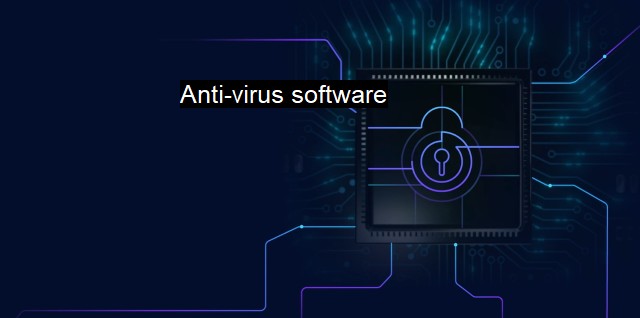What is Anti-virus software?
The Importance of Anti-Virus Software in Cybersecurity: Detect, Prevent, and Remove Malware with Signature Detection, Behavioral Analysis, and AI
Anti-virus software is a sophisticated type of cybersecurity technology designed to protect computer systems and data from malicious attacks. These attacks often take the form of viruses, hence the name 'anti-virus.' Yet, it should be noted that modern anti-virus software has gained significant computational ability to counter a comprehensive spectrum of cyber threats, including malware, ransomware, trojans, worms, and more.A computer virus refers to a malignant program or string of code purposefully crafted to infiltrate a computer system, thus causing damages ranging from minimal disruptions to massive data corruption and loss. These viruses, much like their biological counterparts, are capable of self-replication; they can multiply and attach themselves to other programs or files. While traversing through a network, they infect more and more devices causing widespread damage. In this vein, anti-virus software is designed to act as the immune system for a computer or network, detecting, quarantining, and removing these harmful viruses before they can wreak havoc.
In its most traditional form, anti-virus software chiefly performed scanning processes to detect known strings of malicious code in computers. This method, generally known as signature-based detection, works by cross-referencing every piece of code in the computer system with a database of identified virus signatures. If a string of code corresponds to any of the virus signatures in the database, the program would recognize it as a virus and move forward towards nullifying it.
The continuous evolution and elaboration of malware require a more intricate response. Anti-virus software is now armed with advanced features like heuristic-based detection, where it not only looks for known viruses but also unfamiliar ones. It works via the establishment of activity patterns linked with malware. The software studies the code to recognize whether it presents abnormalities, whether the code is malicious by looking at its structure, properties, and activities.
Anti-virus software utilizes real-time scanning to automatically scrutinize files during download, before opening, or when the system might be vulnerable. This approach considerably reduces the risk of virus infection arising from spontaneous file downloads, email attachments, web browsing, or software installations. Once the software recognizes a threat, it can isolate the infected file to inhibit the spread of the virus, or it can completely delete the file to eradicate the threat from the system.
Most anti-virus platforms also offer widespread security coverage in the form of firewalls, which monitor and regulate all incoming and outgoing traffic. Firewalls serve as the first line of defense against threats aiming to exploit network vulnerability. They also prevent unauthorized users from gaining access to the network or computer. a number of these tools include email protection to stop dangerous email attachments or links from delivering malware, they also show caution when opening suspicious websites to prevent attacks via vulnerable web pages.
It is worthy to note the emergence of cloud-based anti-virus platforms that propose a more contemporary solution to cybersecurity. Contrary to traditional anti-virus software, which depends heavily on system resources for functioning, cloud anti-virus software is run in the cloud, and thus demands minimal processing power. it automatically upgrades itself ensuring perpetual protection against the newest threats.
While anti-virus software is a cornerstone of cybersecurity measures, no system can be wholly impervious to threats. Cybersecurity demands a comprehensive strategy that entails a blend of preventative behaviors, regular software updates, contention recovery plans, and of course, reliable anti-virus software. On an organizational level, this involves user awareness training, network security measures, data backup strategies, and regularly scheduled security audits in addition to major investment in appropriate anti-virus software. In the bona fide digital era, antivirus software constituting a robust cybersecurity strategy has transcended the ambit of choice to become an undeniable necessity.

Anti-virus software FAQs
What is anti-virus software?
Anti-virus software is a type of cybersecurity software designed to detect, prevent, and remove malicious software, also known as malware, from computer systems and networks. It works by scanning files, emails, and data for suspicious activity and blocking or isolating any malware it finds.Is anti-virus software necessary for protecting my computer?
Yes, anti-virus software is a critical component of protecting your computer from cyber threats. Without it, your computer is vulnerable to malware and other malicious attacks which can compromise your data, steal personal information, and cause significant damage.Do I need to update my anti-virus software?
Yes, regularly updating your anti-virus software is essential to ensure that you have the latest and most effective protection against the latest threats. New malware is continually being developed, and software updates contain the most recent virus definitions and security patches to keep your computer safe.Can anti-virus software detect and remove all types of malware?
While anti-virus software is an essential tool for protecting your computer, it can't catch every type of malware. Some types of sophisticated malware can evade detection by anti-virus software, and new strains of malware are continually being developed. It's important to practice safe computing habits, such as avoiding suspicious websites and downloading files only from reliable sources, in addition to using anti-virus software to protect your computer.| | A | | | B | | | C | | | D | | | E | | | F | | | G | | | H | | | I | | | J | | | K | | | L | | | M | |
| | N | | | O | | | P | | | Q | | | R | | | S | | | T | | | U | | | V | | | W | | | X | | | Y | | | Z | |
| | 1 | | | 2 | | | 3 | | | 4 | | | 7 | | | 8 | | |||||||